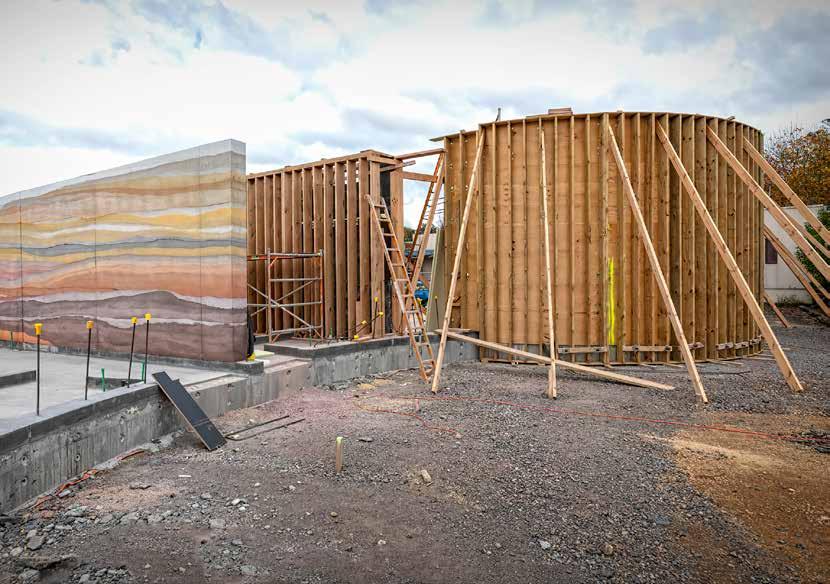
6 minute read
Project spotlight
Known around the world for its quirky, colourful Hundertwasser public loos, Kawakawa is acknowledging this renowned artist and his connection to nature with the development of the new Te Hononga Kawakawa Hundertwasser Park—the first New Zealand commercial building to use rammed earth construction techniques. NZ Plumber takes a look at progress.
AUTHOR: SAM DAY
N
orthland is home to some of New Zealand’s best travel destinations. Whether you’re diving off the Poor Knights Islands or driving down 90 Mile Beach, the region has something for everyone. One of its more obscure attractions, though, is a public toilet squeezed into a tiny section on Kawakawa’s main street. The Hundertwasser bathrooms may be small, but they pack plenty of punch; the public loo attracts 250,000 tourists each year and has become an integral component of Kawakawa’s local economy.
The attraction has also stimulated the development of Te Hononga Kawakawa Hundertwasser Park: a community-led project that centres around the creation of a cultural hub. Te Hononga’s new centre will contain a memorial to Hundertwasser himself, a public gallery and viewing platform, a council service centre, and a community workshop.
Kawakawa’s public library, once a dilapidated Eighties-style construction wedged beside the famous toilets, will now be housed in the park centre and a new ātea (town square) will take the place of the old library, serving as a meeting place and joining together of cultures for the community.
The Park is also expected to take some of the strain off Kawakawa’s main street and off Hundertwasser’s famous bathrooms themselves. It will contain showers and toilets for freedom campers to use, as well as coach and car parking.
The cultural hub is representative of the joining together of Māori and Pakeha, of tourists and locals, of man and the environment, as well as of Kawakawa’s community and Hundertwasser himself. This joining together is embodied in the
This photograph, taken early in the development of the hub, shows the framework for the insulated rammed earth wall. The wall in the foreground was built using soils and sands gathered within a 160km range of Kawakawa.
enduring symbol of two hearts meeting: a design kaupapa developed by four Ngati Hine artists and Pip Bolton, an architectural designer from Avail Pacific.
Although the hub was originally intended to open to the public in February 2020 (exactly 20 years after the original toilets were completed), the opening was slated for April before the COVID-19 pandemic disrupted normal business, whilst the surrounding ātea is scheduled to be completed by November.
A variety of challenges have been overcome in developing Te Hononga. Hundertwasser’s toilets are built on an old river bed, and the project’s construction brief requested that natural materials be used to ensure the hub respected Hundertwasser’s and local Māori values. The issue of building on soft ground was solved by establishing two concrete rib-rafts for the building to ‘float’ on. The SIREWALL (structurally insulated rammed earth wall)
Hundertwasser history
The Hundertwasser bathrooms were the brainchild of Friedensreich Hundertwasser, one of the 20th century’s most distinctive artists. Born Friedrich Stowasser in Austria in 1928, he visited New Zealand in the 1970s and went on to make it his second home. The bathrooms were his last work and were opened in 1999, just a few months before he died in February 2000. They appear as a microcosm of his larger European works: the public loos are peppered with psychedelic designs using multi-coloured tile collages and fanciful shapes. A living tree sprouts through the centre of the toilets, meeting a roof covered in native grasses.
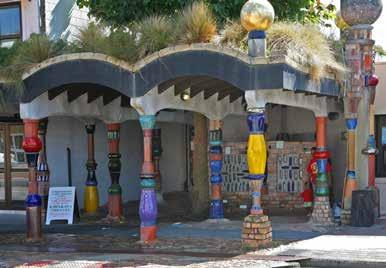
Austrian artist Friedensreich Hundertwasser’s kaleidoscopic designs cover the worldfamous Hundertwasser bathrooms, which opened on Kawakawa’s main street in 1999. Photograph courtesy of Jackie Jackson, Traquo Magazine.
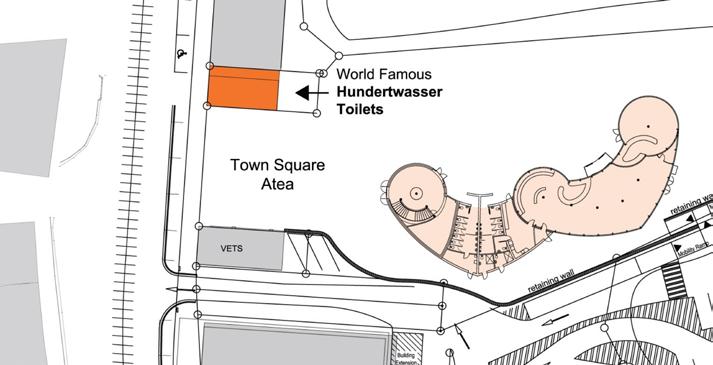
This bird’s eye view of the Te Hononga Kawakawa Hundertwasser Park shows the heart-shaped design of the cultural hub and space for the new Kawakawa ātea, or town square.
technique has been used to create the hub’s walls and fits well with Hundertwasser’s central ethos that “you are a guest of nature—behave”.
Local clay was used to provide walls that are both culturally and environmentally friendly and that also offered the required structural strength of 25MPa. This makes Te Hononga the first commercial building in NZ to use the SIREWALL technique, and the first commercial building to use rammed earth techniques in general.
Twin rammed earth walls, each 180mm thick with 50mm thick insulation between them, help maintain temperature control in the centre’s gallery and library.
Local trainee involvement Twenty local trainees, most of whom were previously unemployed, have assisted with the project as part of a 40-week training programme offered by the Regent Training Centre to give them the skills, confidence and qualifications necessary to turn them into true change-makers for the region.
Michiko Cooper, a 19 year old originally from Christchurch, is the first female apprentice hired by the project’s lead contractor Harnett Builders, and she has been actively involved in all steps of the building process.
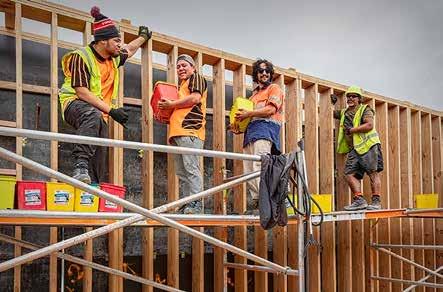
Throughout 2020, the landscape surrounding the park centre will be developed. Paving, planting, painting, laying down mosaics, and land shaping began taking place over summer. Community meetings have allowed locals to sign up to help with the landscape development, ensuring that Te Hononga remains a community-led project that brings people together from all cultures.
Twenty local trainees, most of whom were previously unemployed, have assisted with the project as part of a 40-week training programme.
“Detailed invoices used to take me three or four hours, now it’s three or four clicks”. Luke Trigar Plumbing
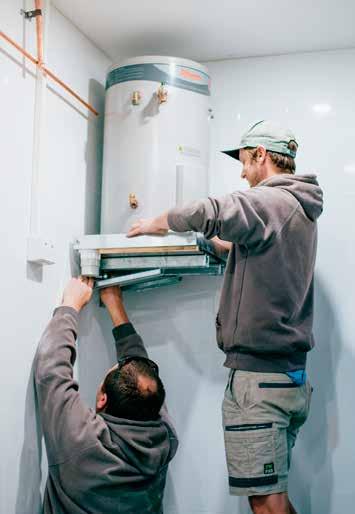
Kiwi through and through. #2
We’re owned by plumbers and 100% of our profits stay in New Zealand.
Start a Free Trial of Fergus and get $50 off your first paid month. Enter the promo code: fergus-mp
KEMPRESS ® STAINLESS STEEL. FASTER. SAFER. SMARTER.
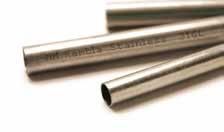
• Made from 316L stainless steel • Higher corrosion resistance and durability
Low carbon content and min. 2.3% molybdenum • High strength and smooth finish
Precision TIG welding, facilitating the perfect “press fit”
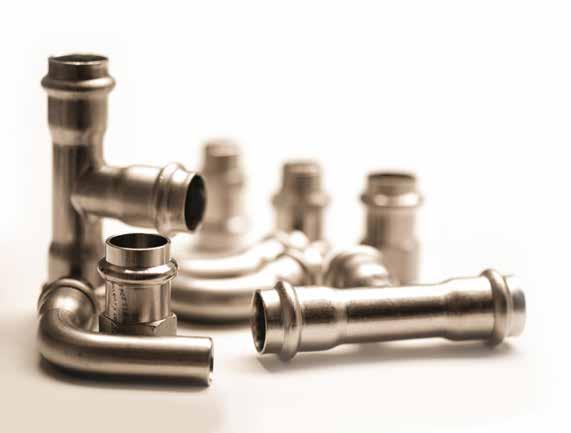
• Huge range of tube and fittings Huge range of tube and fittings in sizes 15 -108mm and pressures up to 4000kPa for Water, Gas & Industrial applications • High performance quality stainless system
Fittings made from MM Kembla Stainless Steel tube, ensuring precise tolerances, tightly controlled quality and full range annealing to ensure material properties required of the highest performance system • National availability, technical and sales support
Renowned MM Kembla quality, reliability and service
Contact MM Kembla for a huge range of stainless steel tube and press fittings and finish fast and in front.
STAINLESS STEEL
Phone: 09 274 0111 or 0800 KEMBLA Email: sales@kembla.co.nz www.kembla.co.nz
MM Kembla NZ Ad 185 x 130mm.indd 1
THE BEST HOMES ARE GRUNDFOS HOMES
PREMIUM SOLUTIONS DESIGNED FOR EASY INSTALLATION
Pressure Boosting
Groundwater
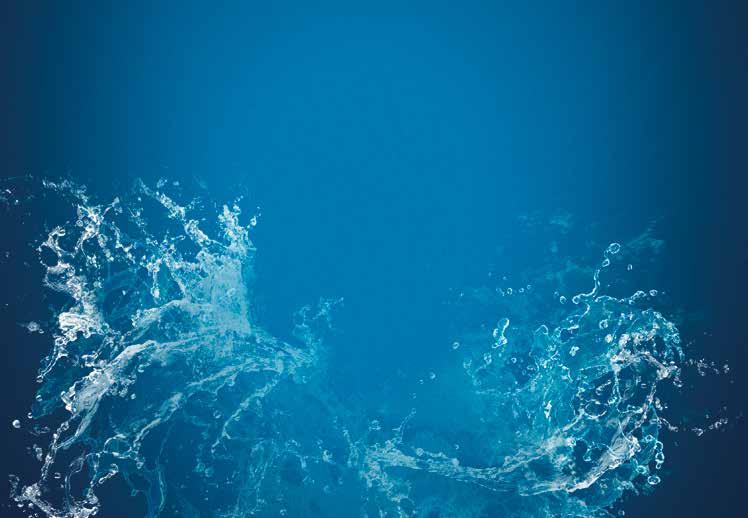
Drainage
grundfos.co.nz
7/2/19 11:58 am









